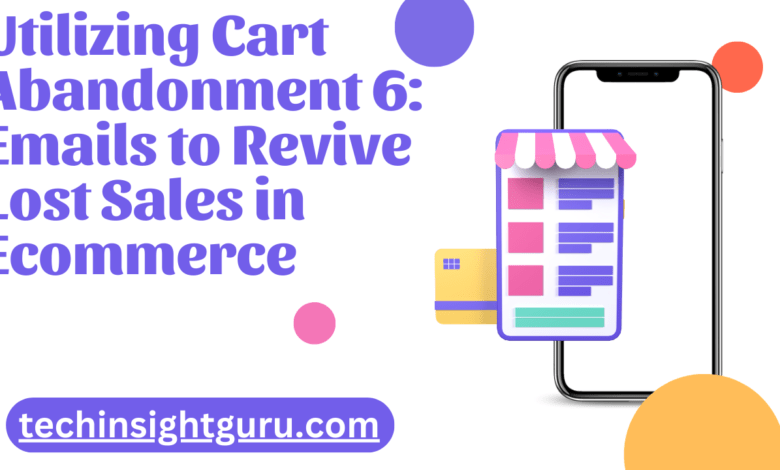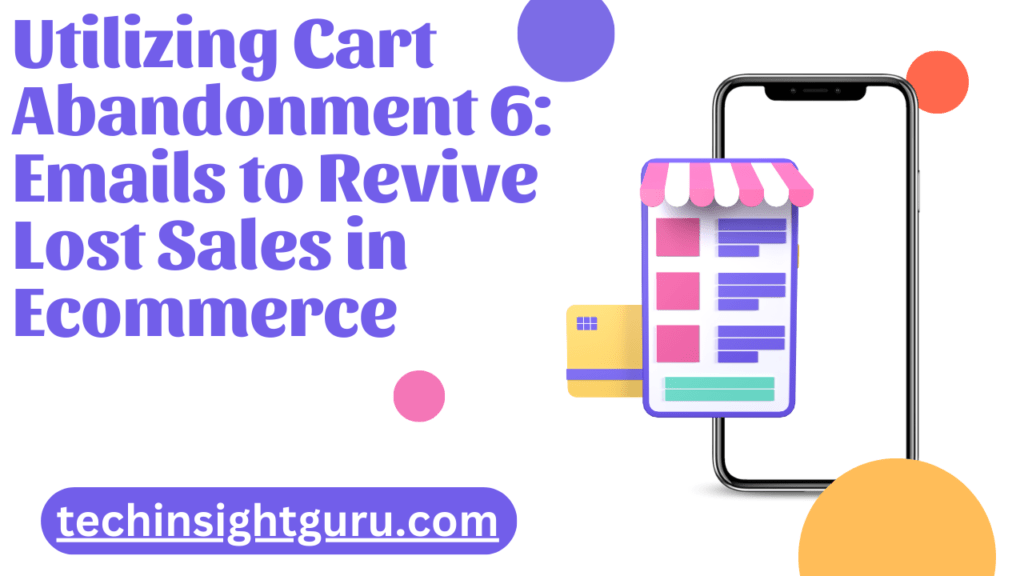
Utilizing Cart Abandonment 6: Emails to Revive Lost Sales in Ecommerce
Introduction
In the dynamic realm of eCommerce, cart abandonment has merged as a significant challenge that directly impacts a c. Abandoned carts signify missed opportunities for sales and revenue, making it crucial for online retailers to employ effective strategies to recover these lost transactions. Among these strategies, cart abandonment emails have proven to be a powerful tool for reengaging potential customers and ultimately converting them into paying customers. In this comprehensive guide, we will delve into the intricacies of cart abandonment emails, exploring their benefits, best practices, and tips for crafting compelling content to recover lost sales in the eCommerce landscape.
Understanding Cart Abandonment
Window Shopping Mentality:
One of the primary contributors to cart abandonment is the casual nature of online browsing. Many users treat their virtual shopping carts as a placeholder for items they are considering, much like a physical cart in a brick-and-mortar store. As a result, a significant portion of added items may not necessarily translate into completed transactions.

Price Sensitivity and Comparison Shopping:
Online shoppers are often price-sensitive and engage in thorough comparison shopping. They may add items to their carts on one website but leave without completing the purchase to explore better deals elsewhere. This behavior is exacerbated by the ease of switching between tabs and exploring multiple online retailers simultaneously.
Unexpected Costs and Fees:
The revelation of unexpected costs during the checkout process is a major deterrent. Shipping fees, taxes, or additional charges that were not apparent during the initial stages of shopping can catch customers off guard. To address this, providing clear and transparent information about all associated costs early in the shopping journey can help manage expectations and reduce cart abandonment.
Complex Checkout Processes:
A lengthy and complicated checkout process is a significant factor that leads to cart abandonment. Users prefer a streamlined experience, and any friction in the form of multiple steps, mandatory account creation, or excessive form fields can discourage them from completing the purchase. Simplifying the checkout process and offering guest checkout options can mitigate this issue.
Trust and Security Concerns:
With the increasing prevalence of online fraud and data breaches, trust and security play a pivotal role in the online shopping experience. A lack of confidence in the security of the website can lead customers to abandon their carts. Implementing robust security measures, prominently displaying trust badges, and ensuring transparent privacy policies are essential in addressing these concerns.
Technical Glitches and Website Performance:
Technical issues such as slow-loading pages, website glitches, or errors during the checkout process can frustrate users and drive them away. Online shoppers expect a seamless and efficient experience, and any hindrance in website performance can result in cart abandonment. Regular monitoring, maintenance, and optimization are critical to ensuring a smooth user experience.
Mobile Optimization Challenges:
As mobile devices become increasingly integral to the online shopping landscape, the lack of mobile optimization can contribute to cart abandonment. Websites that do not adapt well to smaller screens, offer intuitive mobile navigation, or provide mobile-friendly payment options may lose potential customers who prefer shopping on their smartphones or tablets.
Benefits of Cart Abandonment Emails
Recovery of Lost Sales:
The primary and most apparent benefit of cart abandonment emails is the potential to recover lost sales. By sending a timely and targeted email reminding customers of the items left in their cart, businesses can re-engage with potential buyers and provide the nudge needed to complete the purchase. Studies show that cart abandonment emails can significantly improve conversion rates and bring back a substantial portion of abandoned carts.
Personalization Opportunities:
Cart abandonment emails allow for a personalized approach to customer communication. By leveraging customer data and insights, businesses can tailor these emails to include specific product recommendations, personalized discounts, or even a reminder of the unique value proposition that attracted the customer in the first place. Personalized communication enhances customer engagement and increases the likelihood of conversion.
Building Customer Relationships:
Sending cart abandonment emails is not just about recovering a sale; it’s an opportunity to build and strengthen customer relationships. These emails demonstrate a proactive and customer-centric approach, showing that the business values the customer’s interest and is willing to assist in completing their purchase. This can contribute to a positive perception of the brand and foster customer loyalty.
Insights into Customer Behavior:
Analyzing the response to cart abandonment emails provides valuable insights into customer behavior. Understanding which products are frequently abandoned, the effectiveness of different email strategies, and the reasons behind abandonment can inform future marketing and sales strategies. Businesses can use this data to refine their approach and address specific pain points in the customer journey.
Segmentation for Targeted Marketing:
Cart abandonment emails can be segmented based on various factors such as the type of products abandoned, the value of the cart, or the customer’s purchase history. This segmentation allows for more targeted and relevant messaging. For instance, offering a higher discount for high-value items or showcasing related products based on the customer’s preferences can significantly enhance the effectiveness of these emails.
Encouraging Repeat Purchases:
Beyond recovering the initial sale, cart abandonment emails can serve as a catalyst for repeat purchases. Including incentives such as loyalty points, exclusive discounts, or limited-time offers in these emails can encourage customers not only to complete the abandoned purchase but also to explore additional products, thereby increasing the overall lifetime value of the customer.
Automation for Efficiency:
Implementing an automated cart abandonment email system streamlines the process and ensures timely communication. Automation allows businesses to respond promptly to abandonment, increasing the chances of conversion. It also frees up resources, allowing marketing teams to focus on other aspects of customer engagement and strategy.
Best Practices for Cart Abandonment Emails
Timely Delivery:
Timing is crucial when it comes to cart abandonment emails. Send the email promptly after the abandonment occurs to ensure your message is still relevant and the customer’s intent is fresh in their mind. Aim to strike a balance between being prompt and avoiding excessive frequency, as bombarding customers with emails can be counterproductive.
Compelling Subject Lines:
Capture the recipient’s attention with a compelling subject line. Clearly convey the purpose of the email and consider adding an element of urgency or a personalized touch. A well-crafted subject line can significantly increase the open rate of your cart abandonment emails.
Personalization:
Leverage customer data to personalize your cart abandonment emails. Address the customer by their name and include details about the abandoned items. Consider incorporating personalized product recommendations or exclusive discounts based on the customer’s browsing and purchase history to make the email more relevant and appealing.
Clear Call-to-Action (CTA):
Provide a clear and prominent call-to-action in your cart abandonment emails. The goal is to make it as easy as possible for the customer to complete their purchase. Use persuasive language, such as “Complete Your Purchase” or “Claim Your Cart,” and ensure that the CTA button is easily clickable on both desktop and mobile devices.
Dynamic Content:
Make use of dynamic content to showcase the specific items the customer left in their cart. Including images, names, and prices of the abandoned products creates a visually appealing and personalized email. This approach reinforces the connection between the customer and the items they were interested in, increasing the likelihood of conversion.
Incentives and Discounts:
Consider offering incentives or discounts to entice customers back to complete their purchase. This could be a percentage off the total, free shipping, or a limited-time promotion. Experiment with different offers to see what resonates best with your audience, and be transparent about the terms and conditions of the incentive.
Mobile Optimization:
Given the prevalence of mobile shopping, ensure that your cart abandonment emails are optimized for mobile devices. The email should display well on smaller screens, and the checkout process should be seamless on mobile platforms. A significant portion of users may open and engage with your emails on their smartphones, so catering to mobile users is essential.
Follow-Up Sequence:
Implement a follow-up sequence for cart abandonment emails. If the initial email does not yield results, consider sending a series of follow-up emails with slightly varied messaging or additional incentives. However, be mindful of the frequency to avoid appearing intrusive or annoying to the customer.
A/B Testing:
Continuously refine your cart abandonment email strategy through A/B testing. Experiment with different subject lines, content variations, incentives, and delivery times to identify what resonates most effectively with your audience. Regular testing allows you to optimize your approach based on real-time data and evolving customer preferences.
Analytics and Measurement:
Implement robust analytics to measure the success of your cart abandonment email campaigns. Track key metrics such as open rates, click-through rates, conversion rates, and revenue generated from recovered carts. Use this data to iterate on your strategy, identify areas for improvement, and refine your future campaigns.
Crafting Compelling Cart Abandonment Email Content
Personalized Messaging:
Begin your cart abandonment email with a personalized touch. Address the customer by their name and reference the specific items they left behind in their cart. Creating a connection through personalization helps to rekindle the customer’s interest and demonstrates that your communication is tailored to their preferences.

Highlight Abandoned Products:
Feature the abandoned products prominently in the email content. Include high-quality images, product names, and any relevant details that reinforce the value and appeal of the items. By visually showcasing the products, you refresh the customer’s memory and reignite their interest in what caught their eye initially.
Create a Sense of Urgency:
Instill a sense of urgency in your cart abandonment email to motivate prompt action. Utilize phrases like “Limited Stock,” “Exclusive Offer Expires Soon,” or “Complete Your Purchase Now” to convey that the opportunity is time-sensitive. Urgency can be a powerful motivator to push customers towards finalizing their transaction.
Compelling Subject Lines:
The subject line is the gateway to your email content. Craft a subject line that piques curiosity, conveys urgency, or highlights the personalized nature of the message. Avoid generic or overly salesy language and instead focus on providing a clear and intriguing reason for the customer to open the email.
Tell a Story:
Engage customers by weaving a narrative around the abandoned products. Highlight their unique features, benefits, or how they fit into the customer’s lifestyle. By telling a compelling story, you not only showcase the product but also create an emotional connection that resonates with the customer’s desires and needs.
Customer Reviews and Testimonials:
Incorporate positive customer reviews or testimonials related to the abandoned products. Social proof is a persuasive factor in decision-making, and showcasing the positive experiences of other customers can reinforce the desirability and reliability of the products.
Incentives and Discounts:
If applicable, consider offering incentives or discounts to sweeten the deal. This could be a percentage off the total, free shipping, or a buy-one-get-one-free promotion. Clearly communicate the incentive in the email, emphasizing the value the customer will gain by returning to complete their purchase.
Clear Call-to-Action (CTA):
The call-to-action (CTA) is the pivotal element that directs the customer towards completing the purchase. Ensure that your CTA is clear, concise, and visually stands out. Use persuasive language such as “Complete Your Order” or “Unlock Your Cart” to guide the customer seamlessly back to the checkout process.
Mobile Optimization:
Given the prevalence of mobile device usage, optimize your email content for mobile viewing. Ensure that the layout is responsive, images are appropriately sized, and the text is easily readable on smaller screens. A mobile-friendly design ensures that your content is accessible to a diverse audience.
Follow-Up Sequence:
Consider implementing a well-structured follow-up sequence for your cart abandonment emails. If the initial email does not elicit a response, follow up with additional messages, adjusting the content or incentives slightly. A thoughtfully designed sequence acknowledges the customer’s interest while providing varied reasons for them to return.
Social Media Integration:
Integrate social media elements into your cart abandonment email content. Include links to your social profiles, encourage customers to share their potential purchases, or highlight user-generated content related to the products. This integration enhances the omnichannel experience and provides additional touchpoints for customer engagement.
Customer Support and Assistance:
Offer customer support and assistance in your cart abandonment emails. Provide contact information, a link to FAQs, or even a live chat option to address any questions or concerns the customer may have. By demonstrating your commitment to customer service, you build trust and remove potential barriers to completing the purchase.
The key to personalization is:
Begin your email with a personal touch by addressing the customer by name and referencing the specific items left in their cart. This personal connection reinforces the customer’s personality and creates renewed interest in their chosen products.
A Visual Showcase of Abandoned Products:
Display high quality images and details of abandoned products to refresh the customer’s memory. Visual appeal reinforces the attractiveness of items, encouraging consumers to reconsider and complete their purchase.
Create a sense of urgency:
Establish urgency in your content to drive immediate action. Phrases like “limited stock” or “exclusive offer ends soon” create a compelling reason for customers to finalize their purchase immediately.
Clear call-to-action (CTA):
Use a clear and persuasive call-to-action (CTA) that guides customers back to the checkout process. Language like “Complete your order now” emphasizes the action you want to take.
Incentives and discounts include:
Sweeten the deal by offering incentives or discounts. Clearly communicate the value that customers will receive from returning, increasing the attraction of completing their purchase.
Crafting compelling cart abandonment email content involves a delicate balance of personalization, visual appeal, urgency, and strategic incentives. By implementing these strategies, businesses can create emails that not only recapture customer attention but also drive them towards completing the checkout process, maximizing conversions and revenue recovery.
Conclusion
Cart abandonment emails serve as a potent tool for eCommerce businesses to recover lost sales, reengage potential customers, and enhance overall revenue. By understanding the psychology behind cart abandonment, implementing best practices, and crafting compelling email content, online retailers can effectively bring back wandering customers and steer them toward making a purchase. Through strategic execution and continuous optimization, cart abandonment emails can become a cornerstone of a successful eCommerce marketing strategy, fostering customer loyalty and driving growth in a competitive digital landscape.
In summary, the cart abandonment email is an essential tool for ecommerce success; It provides a great way to make up for lost sales, reconnect with customers’ consumption capacity, and increase overall revenue. By understanding cart abandonment sentiment, incorporating best practices, and creating email content, online retailers can skillfully engage with customer complaints and drive them to complete the purchase. Thanks to practical use and constant improvement, these emails are gradually becoming the foundation of a successful e-commerce business, not only increasing revenue but also ensuring customer loyalty. In a competitive digital environment, this approach facilitates growth.
In the commerce business, cart abandonment is not the end This is a call to action. It calls on businesses to innovate, adapt and continuously strive to achieve a communication and customer centric journey. As we begin this new chapter, let’s follow the lessons learned and continue to turn the race into time, one car at a time.
visit: mishitechtalks.com/ai-and-business-intelligence-driving-data-driven-decisions


4 Comments